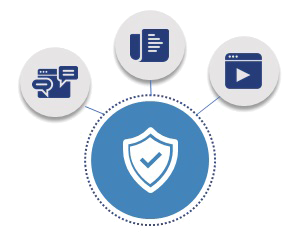Identity and Access Management in the Energy Sector

Challenges Impeding Security in the Energy Sector
Many companies within the energy and utility sector operate manual processes and ad-hoc solutions that prove too costly, time-consuming, and inaccurate to meet customer needs, protect company assets and meet stringent requirements of dynamic industry regulations. There is minimum convergence of the IT processes and the engineering divisions responsible for the sector’s operations, making it challenging to meet cybersecurity requirements.
With the current digital transformation in the sector, energy providers are replacing or upgrading outdated infrastructure to leverage the capabilities of emerging technologies. The process leads to an increase in the number of technologies, devices, applications, and services connected to utilities’ grid networks and needs protection from cyberattacks.
The Canadian Center for Cyber Security (the Cyber Center) recognizes how information systems upholding Canada’s national electric infrastructure are subject to cybersecurity threats. Fraud and ransomware are at the top of Cyber Center’s list of the most observed digital threats against Canada’s electrical organizations. A case in point is the Northwest Power Corporation attack that shut down emails and websites, leaving some pages to display a ransomware message from unknown threat actors. Hackers will continue honing their tactics to spread ransomware across IT networks and industrial control systems (ICS).
Over and above direct cyberattacks, interdependencies of Canada’s utility sector with the U.S. grid amplifies risks. Ostensibly, Canadian energy providers still face digital attack threats due to their interconnections with the U.S. grids. More than 35 electricity transmission line connections run across provinces bordering the United States.
Meanwhile, when it comes to protecting critical infrastructure, it is common for organizations to prioritize external risks that breach the security perimeter, such as hackers breaking through firewalls or injecting a virus. Without casting doubt on the importance of external security for the energy sector, most organizations overlook security risks originating from within.
Other than operating manual processes and prioritizing external risks, energy sector service providers have networks that run independently, resulting in identity and access information disparity, increased costs, inefficiencies, and loss of capacity and service delivery, according to NIST Special Publication – 1800-2.
Some utility companies implement IAM, but the systems are often decentralized and managed by disparate departments within a company. This setup leads to several adverse outcomes, including an increased risk of attack, service disruption, inability to identify potential sources of a problem, and lack of overall traceability and accountability regarding who has access to which asset. Employees managing such systems lack the expertise and methods to effectively coordinate and control access to siloed equipment, systems, and devices.
How do identity and access management (IAM) solutions help secure the energy and the utility sector that faces sophisticated threats and a challenging regulatory environment? Contact KeyData today to learn more.
Enhancing Security in the Energy Sector with IAM
To survive incidents like the recent Colonial Pipeline ransomware attack, the energy sector must rethink how they handle their security strategies to remain secure and efficient. Besides, they need to devise solutions to meet the demands of escalating compliance mandates featuring strict industry standards and business regulations.
Identity and access management solutions provide tools and services to track user access to utility service providers’ systems, networks, and applications, automatically generating user access activity logs. IAM solutions add a layer of protection that ensures user access rules and policies are consistent in an organization.
“To protect power generation, transmission, and distribution, energy companies need to control physical and logical access to their resources, including buildings, equipment, information technology (IT), and operational technology (OT),” writes James McCarthy and others in NIST Special Publication – 1800-2. “They must authenticate authorized individuals to the devices and facilities to which they are giving access rights with a degree of certainty.”
Proper IAM solutions automate identity and authentication processes, reducing the overall friction users experience when requesting access to services. Such solutions provide businesses with the ability to understand and govern access, especially with the increased staff mobility and the use of cloud computing that allows employees to work from different places. Identity is the new perimeter as the energy sector evolves and moves towards hybrid on-premises and cloud environments.
Over and above security and regulatory compliance capabilities, energy providers that tackle IAM effectively can empower trusted employees and users to connect to critical resources from any location, enhancing productivity. This capability comes in handy, especially when the COVID-19 pandemic has confided people to working from home. According to a 2021 Global Cloud Identity and Access Management (IAM) Industry market report, IAM systems are an essential part of security for enterprises and industries, given their inherent association with productivity.
Get Started with KeyData
KeyData helps companies address their IAM needs in the energy sector, including electricity, oil, coal, solar, geothermal, and gas. KeyData provides a risk-based framework and unique methodology in the areas of Identity and Access Management (IAM), Customer Identity and Access Management (CIAM), Privileged Account Management (PAM), and cloud security management, enabling energy sector stakeholders to transform through industry-leading consulting and system integration services.
KeyData also offers in-depth expertise and experience to meeting energy sector security challenges and incorporates a business value mindset by identifying and managing the strategic considerations while implementing new technologies. KeyData has end-to-end IAM solutions that energy providers of varying sizes can tailor and implement to meet their specific needs.
Whether your organization is in the planning stage or is just completing the IAM implementation, KeyData provides end-to-end services for comprehensive risk management. What’s more, the professional solutions integrate with commercially available products that can be included alongside an energy provider’s existing infrastructure, resulting in a centralized system with a comprehensive view of all users within the enterprise and across the operational, engineering, and IT silos that characterize the sector. This capability helps the sector amp up security by adding an identification and authentication strategy in the background without impacting usability.





